
When you set out to watch every James Bond movie, there is something forever looming in the distance, threatening even, something you know you'll have to deal with eventually. Yes, to attempt such a marathon means you will at some point have to watch the film, You Only Live Twice (1967), where Sean Connery - 6'2", as Scottish as the day is long - goes undercover as a Japanese man.
But, the Bond superfans will say, that same movie also has Donald Pleasance as Blofeld, a classic Nancy Sinatra song, a screenplay by Roald ( Charlie and the Chocolate Factory) Dahl, stunning cinematography from the guy (F.A. Young) who shot Lawrence of Arabia, multiple scenes of a giant space rocket more or less swallowing another space rocket, Bond in something called a gyrocopter, people falling into a piranha pit, and one of the all-time great Ken Adam sets - an evil lair inside a volcano!
Surely there's enough good there that you can live with a little Breakfast at Tiffany's era racism.
Is there, though?
Spoiler: The answer is yes. If you can accept the sight of Connery passing for Japanese, You Only Live Twice is one of the truly quintessential Bond films. So, where do I get off not totally loving it?
But, Wait, They Promised They Were Going to Make On Her Majesty's Secret Service!
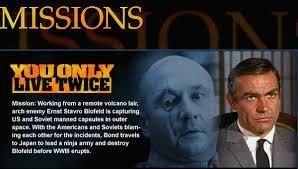
The backstory: During the production of Thunderball, United Artists announced a contest to find 12 women to appear in James Bond's next movie, On Her Majesty's Secret Service. Yes, they'd already promised to make On Her Majesty's Secret Service after Goldfinger, but this time they really meant it. James Bond would finally save the world from Blofeld's plan to save the world from allergies! [Record scratch.] No, seriously, that's the plot of the Ian Fleming OHMSS book. There's an evil villain twist in there somewhere, and it involves Blofeld brainwashing women and wrecking the world's agriculture.
That's where the contest came in. Richard Maibaum's tentative script called for 12 angels of death from all over the world. What a great opportunity to turn a casting call into a contest and stir up some publicity!
Not that the Bond franchise really needed any extra publicity. No Bond film before or since, not even Skyfall, sold more tickets than Thunderball. Before that, Goldfinger had gone into the Guinness Book of Records as the fastest grossing film of all time - not highest, but fastest, meaning not even Gone With the Wind made as much as quickly as Goldfinger. (Ticket prices were cheaper back then, I know.) After all that, Bondmania was practically a diagnosable condition, rivaled in intensity by only Beatlemania. News reports of the time were chock full of interviews with young women who were dying to be cast in a Bond movie.
Then Sean Connery threatened to quit the franchise. [There's that damn record scratch again.]
He was under contract for two more movies but felt typecast and underpaid. Maybe it wouldn't have been so bad, this James Bond gig, if the movies didn't take so dang long to make and promote. As it was, his Bond commitments were costing him to lose out on other projects he wanted to make and the salary he received wasn't enough to make up for that, at least not in his eyes. (Sure, he made a lot off of Thunderball and had already earned a million-dollar salary for the 1964 non-Bond crime thriller Woman of Straw, but, um, shut up about that.) So, Connery took to the Hollywood trades like Variety to float the idea of maybe refusing to honor his contract.
The producers were publicly insistent that everything would work itself out but behind the scenes, Cubby Broccoli and Harry Saltzman were entering into their own kind of divorce. Increasingly prone to simply shouting at each other, Broccoli and Saltzman decided it would be best if they continued co-running Eon but divided their efforts. When one of them was working on a Bond picture, the other could spend more of their time developing other movies. So, with the next Bond film, Broccoli would take the lead. That film, obviously, did not turn out to be On Her Majesty's Secret Service. Sorry, contest hopefuls.
Why They Made You Only Live Twice
OHMSS was delayed, again, this time in favor of Fleming's Japan-set, 1964 Bond novel You Only Live Twice. The classic explanation for the change is location scouting for OHMSS' s central snowy mountain resort proved fruitless, especially during an uncommonly warm Swiss winter, but it might have also been influenced by their efforts to appease their vocally disgruntled star.
By switching to a Bond story that didn't require them to film in the snow, they could push back the start of production from February to later in the summer and give Connery a little extra time off. They also agreed to limit his shooting schedule to sixteen weeks, and then once filming on You Only Live Twice started, they released him from his contract. If Connery wanted to walk after You Only Live Twice, they couldn't legally stop him - which, of course, is exactly what ended up happening. He announced his intent to leave before they'd finished production.
Before they could reach that particular bridge, however, there was still the little business of actually making You Only Live Twice. For that task, they turned to a soon-to-be Oscar-nominated director/producer ( Alfie's Lewis Gilbert, who had to be talked into it) and a pair of Oscar-nominated screenwriters: Sydney Boehm ( The Atomic City), who penned a faithful script treatment of the Fleming novel, and Harold Jack Bloom ( The Naked Spur), who adapted the treatment into a full screenplay.
There was one big problem: they couldn't find most of the memorable landmarks featured in Fleming's novel. The story in the book climaxes in a "toxic garden of death" in a castle near the sea, but after three weeks spent scouting nearly all of Japan via helicopter they'd yet to discover a single seaside castle. What did catch the team's eye, however, was one southern island populated with extinct and not-so-extinct volcanoes. From the sky looking down, a volcano's crater struck them as the perfect cover for a Bond villain's secret lair.
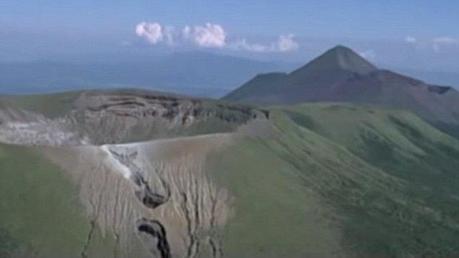
So, the order came in: write the script around that volcano. When Broccoli and Saltzman didn't like what Bloom did with that, they replaced him with children's author Roald Dahl, who was then developing a different script for United Artists but was not yet a true screenwriter. Dahl, like Fleming, served in British intelligence during WWII, and the pair became friends. Fleming's novels were huge hits, however, whereas Dahl's children's novels were only modest sellers at the time. He didn't much care for You Only Live Twice, describing it as "tired, bad, Ian's worst book."
Why take the gig of adapting it? He needed the money. But why did the Bond people want him to do it? According to Gilbert, "We needed his storytelling skill to strengthen Fleming's plot and his dark humour to complement it."
Dahl rather candidly admitted he didn't know what he was doing but had deadlines to meet. So, he used Dr. No as inspiration for the story structure, reflected some of the headlines of the moment (spacewalking, missing U.S. aerial equipment, perpetual threat of WWIII) and handed in a final draft which he told his agent was "the biggest load of bullshit I've ever put my hand to." Broccoli and Saltzman loved it.
Bloom, it should be noted, maintained long afterward that Dahl just rewrote most of his own ideas and that he should have been awarded a co-writing credit. Dahl claimed to have never even read Bloom's draft. Regardless of proper accreditation, though, what's up there on the screen is a cracking good James Bond story, pacing 007 through an ever-escalating scale of improbable events that mean simply to entertain.
James Bond Died Today
In a clear sign of the franchise's shift toward fantasy, You Only Live Twice opens in space where an advanced missile capable of space flight and re-entry kidnaps an American space capsule and its crew. (Lewis Gilbert repurposed this giant-ship-swallowing-smaller-ship trick a decade later in The Spy Who Loved Me but hoped no one would notice.) The irate Americans have their fingers pointed straight at the Russians, who are coldly defiant. China, positioned as an emerging world power, stands to benefit greatly from possible US-Russian conflict. Say, China couldn't be paying someone to stir this particular pot, could they?
Spoiler: Yes, they totally are.
It's up to the Brits to be the voice of reason and point out that their intelligence has traced the mysterious spacecraft to the Japanese shoreline. 007 must get to the bottom of it to prevent WWIII.
007? Isn't he dead?
As the You Only Live Twice theatrical trailer so memorably put it, "Sean Connery James Bond." Yes, coming on the heels of all the press speculation about whether Connery's time as Bond was up, You Only Live Twice opens by killing him off, and he goes out exactly as you'd expect: ambushed while in bed with a beautiful woman.
Except there's still around two hours of movie to fill. You know he's not really dead. Still, what a nice little jolt of an opener. It turns out MI6 just faked his death so his enemies might let their guard down.
Everything about that is great - the faked death, the Sinatra song, the prospect of a Bond villain hijacking the then red-hot space race to kickstart war, the spy movie fun of Bond getting to the bottom of an international mystery, and the promise of visiting yet another exotic location, in this case Japan. Indeed, everything about You Only Live Twice is truly exceptional Bond moviemaking...until around the time he pretends to be Japanese.
Turning Japanese
Yes, You Only Live Twice definitely fails to meet the 2020 cultural purity test, not that it's particularly shocking since we are talking about a movie from 1967. Bond's sleuthing in Japan with help from local secret service head Tiger Tanaka (Tetsurō Tamba) and agent Aki (Akiko Wakabayashi, on loan from the Toho "Godzilla" Studios) reveals the country is crawling with SPECTRE agents. Plus, there is something seriously amiss with one particular volcano range since Bond's simple reconnaissance mission in Q's "Little Nellie" gyrocopter ended with him attacked by four helicopters.
To get closer to the volcano, it's decided, Bond must go undercover as a Japanese fisherman on a small, nearby island. "You become a Japanese, train to be ninja, marry local girl," Tiger says repeatedly as if it's the most natural thing in the world.
What trips me up here isn't really the "what were they thinking?" sight of Sean Connery in wig, eyebrow extenders, and kimono. 1967 was a long ass time ago. It wasn't cool then, certainly isn't now, but it is what it is. I'm actually more thrown by the way this part of the film seems to lose the plot.

Bond's tense, but also enjoyably over-the-top (a car full of baddies is dropped via magnet in the middle of Tokyo Bay!) spy adventure gives way to a middle section that doesn't really pay off. Neither his laughable mastery of the ways of the ninja (Bond knows ninja star) nor his masquerade as husband to local diving girl Kissy Suzuki (Mie Hama, also on loan from Toho Studios) feel like they're actually integral to him getting into that damn volcano and punching his way to world peace. Instead, they feel like contrivances designed to shove ninjas into the movie and engage in some cultural tourism, marching Connery through an actual small Japanese village and wedding ceremony.
To be fair, though, Bond does go undercover in a small Japanese village in the book, and part of the Bond movie appeal is the tourism. We vicariously live through him as he tours every exotic locale imaginable in the world, and to many a moviegoer in 1967, I'm sure You Only Live Twice was their first time seeing any of the real Japan outside of a Godzilla movie, where Japan always seems to end up crushed. Heck, this is my first time watching this movie, yet somehow I'd long ago seen the image of the ninja charging toward the camera with his sword like an absolute madman.
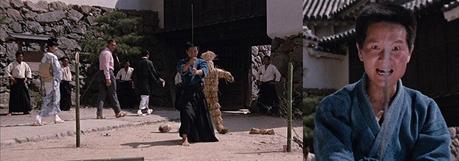
You Only Live Twice is that kind of you've-already-seen-it-even-if-you-haven't iconic. I'd also be lying if I said I didn't enjoy the scenes at the ninja trailing school or Bond's wedding or just about any time F.A. Young's camera works its Lawrence of Arabia magic on the stunning Japanese beaches, mountains, and bustling cities. So, though I might quibble with the plot mechanics, I love taking in the sights.
So Evil That You Would Say It Was E-VEEL
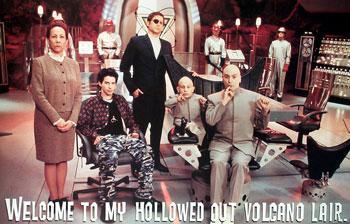
On top of the casual racism of a Scot posing as Japanese, there is another shadow hanging over You Only Live Twice: Austin Powers. After being heard and glimpsed from behind in From Russia With Love and Thunderball, Ernst Stavro Blofeld (Donald Pleasance, cast in a rush after filming with their first choice, Jan Werich, produced terrible results) makes his on-screen debut in You Only Live Twice. He's bald, wears a grey suit, has a scar down his face, lives in a hollowed out volcano lair, has a thing for using trap doors to violently off disappointing underlings who has, and is generally an especially demented kind of evil.
Sound familiar?
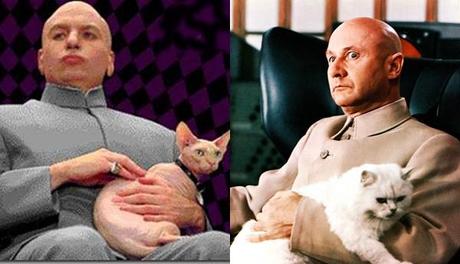
Yes, I know it's inherently unfair to view a movie through the lens of its own parody, and the Dr. Evil comparison isn't even always a straight one-to-one. Mike Meyers, for example, was never really trying to make himself sound like Donald Pleasance. Instead, his Dr. Evil voice is more an impression of his old SNL producer Lorne Michaels. I admit, though, the Austin Powers similarities threw me.
Beyond that, after having heard so much about Donald Pleasance's performance I was a bit let down. His Blofeld, though originally voiced and performed by someone else in the prior Bond pictures, is the OG Thanos, the big bad teased across multiple movies to build anticipation. You Only Live Twice, however, persists with the franchise's cloak and dagger act of showing Blofeld from behind or maybe merely glimpsing his arm for nearly two thirds of the movie. So, once he and Bond finally meet face to face, it is clearly an iconic moment, built up and teased with surprising patience:
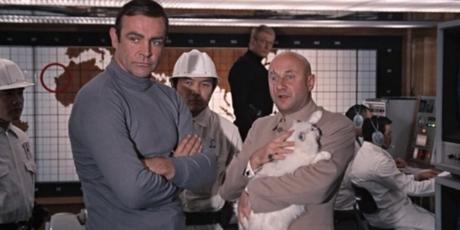
Yet it left me wanting more. I wanted more of a sense from Blofeld that Bond has been a thorn in his side for too long, ruining all of his plans in the prior movies. I wanted there to simply be some actual drama between the two of them. Instead, even with Pleasance's admittedly fun performance it's all quite clearly the thing that set the template for the countless threaten-the-world-from-evil-base-but-always-have-a-badass-bodyguard Bond villains to come, from Spy Who Loved Me to all the way to Tomorrow Never Dies.
But if the classic Bond mold always boils down to 007 essentially storming the villain's castle as the camera pulls back to marvel at the spectacle on screen, You Only Live Twice set the bar pretty high. The sheer logistical challenge of coordinating hundreds of stuntmen to descend down ropes - some of them one-handed since they're firing a gun with their other hand - from a 125 foot-tall set like Blofeld's volcano lair is impressive enough. To then have those men immediately fight other stunt performers - a classic our army in one color of jump suit versus your henchmen in another color - is just insane.
Like a lot of other things in You Only Live Twice, a finale like that leaves you thinking: they just don't make 'em like this anymore. In some areas, like putting a Beatles wig on Sean Connery and pretending it makes him Japanese, it's good that we've evolved since 1967. In other areas, like presenting an actual sumo match for free to the public just so you can get 12,000 extras to provide ambiance during a 2-minute dialogue scene, I miss the sheer chutzpah - and apparently bottomless resources - of the old Bond moviemaking machine.
MARATHON NOTES
Thoughts on the Bond Women: When writing the script, one of Dahl's must-haves from the producers was that his story must include three women - no more, no less. Beyond that, there was a very specific formula to be followed - a devout ally who dies halfway through, a femme fatale who can't resist Bond's sexual charm and also dies halfway through, and finally the real Bond girl who must under no circumstances die nor have sex with him until the final scene. Mission accomplished, I guess, though do wish Karin Dior's SPECTRE agent Helga Brandt could have stuck around longer to get a proper final confrontation with Bond.
Ian Fleming Connection:Published in 1964, You Only Live Twice opens with a haiku which, in part, reads "you only live twice, once when you are born, and once when you look death in the face." (Chilling since Fleming died, at the age of 56, the year the book was released.) The story sees Bond, still mourning the death of his wife in the OHMSS novel, sent to Japan to secure secret Japanese-American communications. There, he meets a sinister foreigner who turns out to be Blofeld in disguise. To beat the rat bastard, Bond dons a disguise as well, going undercover in a small fishing village where he befriends a failed Hollywood actress named Kissy Suzuki. The story grows to include a suicide cult, toxic garden, volcanic explosion, a pet bird named after David Niven (!), amnesia, and baby daddy drama.
Bond Song Thoughts: Nancy Sinatra, who came recommended by her famous father - and Cubby Broccoli's friend - Frank, muddled her way through the challenging record session. She later claimed she'd rather have a root canal than go through that ordeal again. The version heard in the film is actually a clever composite of around 25 different takes. Sinatra also released a more club friendly version of the song but the one heard in the film is the one that has endured. It's up there with "Live and Let Die" as one of my personal favorite Bond songs.
Coolest Scene: Being chased by bad guys through Japan? Oh, there's a magnet for that!
Favorite Line: Tiger Tanaka: "In Japan, men come first, women second." / Bond: "I just might retire to here." That might seem a bit ewww today, but it is a perfect Sean Connery James Bond line.
Biggest regret: That I saw Austin Powers: International Man of Mystery before this.
Little Known Fact: In early March 1966, Japan suffered two tragic plane crashes on subsequent days. On March 4, over sixty passengers and crew died in a fiery crash in Tokyo. On March 5, a second plane hit Mt. Fuji just 25 minutes after takeoff, killing 113 passengers and 11 crew members. The You Only Live Twice crew, a group that included Ken Adam, was meant to have been on that second flight but canceled at the last second when told they had a chance to watch a ninja demonstration. So, really, ninjas saved them.
Box Office: $111.6m worldwide/$857.9m inflation-adjusted, a notable but not entirely damning decline from Thunderball 's record-breaking numbers two years earlier ($141.2m worldwide/$1.153 billion inflation-adjusted)
Sources: Nobody Does it Better, The Ultimate Guide to Bond, Some Kind of Hero
TOMORROW: Thunderball

